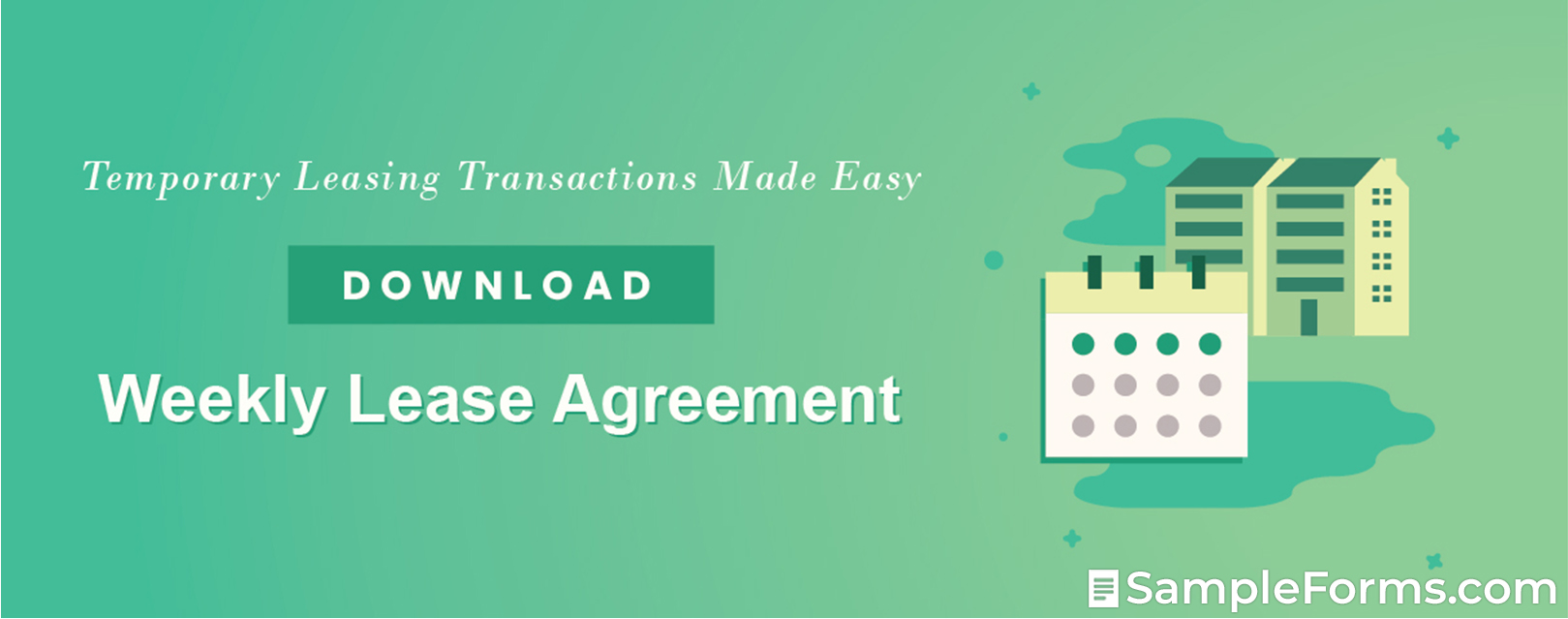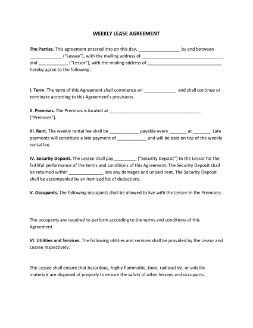- Eviction Notice Forms
- Power of Attorney Forms Forms
- Bill of Sale (Purchase Agreement) Forms
- Lease Agreement Forms
- Rental Application Forms
- Living Will Forms Forms
- Recommendation Letters Forms
- Resignation Letters Forms
- Release of Liability Agreement Forms
- Promissory Note Forms
- LLC Operating Agreement Forms
- Deed of Sale Forms
- Consent Form Forms
- Support Affidavit Forms
- Paternity Affidavit Forms
- Marital Affidavit Forms
- Financial Affidavit Forms
- Residential Affidavit Forms
- Affidavit of Identity Forms
- Affidavit of Title Forms
- Employment Affidavit Forms
- Affidavit of Loss Forms
- Gift Affidavit Forms
- Small Estate Affidavit Forms
- Service Affidavit Forms
- Heirship Affidavit Forms
- Survivorship Affidavit Forms
- Desistance Affidavit Forms
- Discrepancy Affidavit Forms
- Guardianship Affidavit Forms
- Undertaking Affidavit Forms
- General Affidavit Forms
- Affidavit of Death Forms
Weekly Lease Agreement
Getting into short-term leases can be both easy and tricky. It can be easy because all it takes is only seven days for you to look out for your property. And it can be tricky because anything can still possibly happen to your property within seven days. Ensure that both you and your guests will feel safe with each other with a weekly lease agreement. Read More
Weekly Lease Agreement
What Is a Weekly Lease Agreement?
Use and get into a weekly lease agreement should you have guests in your Airbnb, guest house, and other similar rental properties for seven days. This type of agreement covers the rules and responsibilities of both the landlord and the tenant, from the number of guests allowed to the deadline of the amount payable.
How Do You Create a Weekly Lease Agreement?
In securing a healthy landlord-tenant relationship, there is a need to create a comprehensive and well-written house lease/rental agreement form right from the outset. Below are some guidelines that both parties should review and consider when making and filling out this type of agreement form.
1. Determine and Outline the Parties Involved
Like any type of agreement form, your house rental/lease agreement form will start with the introduction of the landlord and tenant who will be referred to as “party” or “parties” throughout the document. This section contains the basic details of the parties involved. Such information includes their full legal names, current addresses, and the agreement creation date. Indicating such information is a form of additional insurance and assurance for both parties.
2. Describe the Property Being Leased/Rent
Provide a brief description of the house that is being leased/rented. This section indicates the type of property and its complete address, including its building and unit numbers, if applicable. If the property features storage and parking areas, be sure to also include such details in this section. And if there are areas in the property that the landlord does not want the tenant to access, ensure to indicate this in the agreement form explicitly.
3. Settle the Lease/Rental and Payment Terms
When it comes to tenancy agreement forms, the lease/rental and payment terms will always be the highlight. Upon writing the lease/rental terms, define whether the term of the tenancy is short-term that will renew automatically or long-term that runs for at least a year. Once cleared, indicate the commencement date, the length of tenancy, and the expiration date. When outlining the payment terms, spell out the amount payable, fixed or expected date of payment, acceptable payment methods, and details on late rent fees and grace periods.
4. Include Basic Rules and Policies
While there could be a separate provision of a rules and regulations document, you can still indicate some of the basic but most essential policies in the house lease/rental agreement form. Most landlords will indicate policies on limiting potential liabilities from illegal activities, restricting all forms of smoking, and prohibiting all types of pets. If you have exceptions such
5. Set the Grounds for Termination
Well-written termination details can avoid any unnecessary disputes in all future dealings. In the possible event that lawsuits and claims will arise, a well-drafted termination can come in handy to strengthen one or both party’s defense against such. Discussing the termination details could also provide an avenue for both parties to review their expectations and concerns and assess potential landlord-tenant relationship roadblocks.
FAQ
When is a house lease/rental agreement form necessary?
Federal, state, and local laws govern the landlord-tenant or lessee-lessor relationship and the overall residential property rental aspects. The absence of an agreement alone is already an invitation for a lawsuit. Without an agreement, both parties will hardly strengthen their claims.
What are the benefits of having a house lease/rental agreement form?
Sealing the deal between landlords and tenants with a handshake will not suffice—signing a clear lease/agreement form must take place. With a signed agreement form, both parties can avoid future disputes, help deal common tenancy issues, comply with federal, state, and local landlord-tenant laws, and protect each other’s interests.
What is the price range for leasing/renting a house?
Most houses are charged based on a percentage of its market value, and most landlords charge between 0.8% and 11% according to SmartAsset. For instance, if the value of your home you are renting out is at $500,000, you can charge your tenants a monthly rental fee between $4,000 and $5,500.
Can either of the parties break the lease/rent?
Both parties, unless a specific termination clause in the agreement form allows, could not break the lease before the agreed end or expiration date. However, it is possible that both parties can settle the cancellation amicably, but no party can decide on its own.
How to put up a house for lease/rent?
Seek the assistance and services of your local real estate agent to help you list your house for lease/rent. Another cost-effective alternative you can opt for is to publish your own residential property listing and upload it on listing websites for free.
There is a proverbial expression that a man’s home is his castle; unfortunately, the circumstances of the modern world have led many individuals to rent castles instead of owning them. However, this does not mean that they can no longer build a fortress to protect their interests and that of the landlord or lessors—this is precisely the role that a house lease/rental agreement form can fulfill. Should you have any plans to enter the rental society either as a landlord or a tenant, see to it that you have already acquainted yourselves with the basics of a house lease/rental agreement form.

